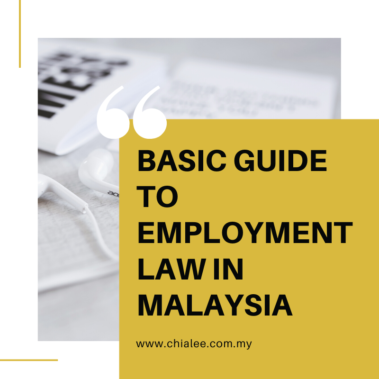

This article is dedicated to all the employers, employees or the soon-to-be employers or employees in Malaysia.
The employment law in the private sector in Malaysia is mainly provided in the Employment Act 1955 (“the EA”), among others sources of law, which shall be applicable in the Peninsular Malaysia and the Federal Territory of Labuan.
In light of the impending extensive amendments to the EA which is now at its final stages of public engagement before tabling in the Parliament, this article serves to provide a basic understanding of the current state of the law before the amendments set in.
The proposed amendments to the Employment Act 1955 can be seen in the Ministry of Human Resource web link as follows:-
There is, however, a different set of employment law in the public sector which governs the civil servant under the purview of the Public Service Commission.
For clarity, the sources of employment law in Malaysia are basically found in:-
(a) the statutes, being the Parliament made law or an Act of Parliament
(b) subsidiary legislation, being the ministerial orders or regulations made under the relevant empowering statutes
(c) case laws refer to such judicial precedents found in the law reports for future similar cases to be treated alike.
It is important to note that the EA only covers the following categories of employees as stated in the First Schedule of the EA.
(a) any person, irrespective of his occupation, who has entered into a contract of service with an employer under which such person’s wages do not exceed RM2,000 a month; and
(b) any person whose wages exceed RM2,000 a month has entered into a contract of service with an employer in pursuance of which:-
(i) is engaged in manual labour;
(ii) is engaged in the operation or maintenance of any mechanically propelled vehicle operated;
(iii) supervises or oversees other employees engaged in manual labour;
(iv) is engaged in any capacity in any vessel registered in Malaysia; or
(v) is engaged as a domestic servant.
There is no distinction between ‘contract of service‘ and employment contract in law. But, one must distinguish that from ‘contract for service’ is a contract to engage independent contractors who are self-employed, for their work.
All in all, the Malaysian employment law does not recognize a contract with a mixture of both ‘contract of service’ and ‘contract for service’.
A contract of service also includes an apprenticeship contract which is a written contract entered into by a person with an employer who undertakes to employ that person and train or have him trained systematically for a trade for a specified period which shall not be less than two years in the course of which the apprentice is bound to work in the employer’s service.
However, it must be noted that such apprenticeship contract must be distinguished from the master and pupil relationship under the Legal Profession Act 1976.
In fact, the Rules and Rulings of the Bar Council 10.09 provides that a master shall not, under any circumstance enter into any contract of or for service, with his/her pupil.
In another word, there cannot be employer-employee relationship in the case of master and pupil.
For the employee who does not cover by the EA, his employment relationship with the employer boiled down to the employment contract or contract of service, subject to such other statutes and case law mentioned above in the sources of employment law.
Provided that the employee covered under the EA as stated in the First Schedule, it is the law that any term and condition of the employment contract or contract of service, which is less favorable than the provisions under the EA or any other regulations made thereunder shall be ‘void’, as per Section 7 of the EA. Section 7 of the EA further states that such term which is less favorable shall be substituted by those prescribed under the EA.
At this juncture, it is worth noting the other 6 Interesting Facts about Employment Contracts in Malaysia at the outset.
Section 2 of the EA defines a ‘contract of service’ as an agreement, be it oral or in writing, whether by implied or express conditions, where a person is engaged as an employee to serves his employer.
Notwithstanding that, Section 10 of the EA provides that such contract of service or employment contract shall be in writing if the period of employment is more than a month. It shall also include a termination clause by either party.
Section 19 of the EA provides that every employer shall pay to each of his employees no later than the 7th day after the last day of any wage period. Depending on the employment contract, wage period will normally be 1 month.
If there is no wage period mentioned in the employment contract, the wage period shall be deemed to be 1 month.
‘Wages‘ means the basic wages and all other payments in cash payable to an employee for work done in respect of his employment contract excluding such allowances, expenses and lawful deductions in the course of his employment.
There is basically no legal provisions for the required period of probation. Normally, it ranges from 1 to 6 months depending on the industries the employees are in.
Probation refers to a trial period of employment which can be culminated in the employees being confirmed or terminated.
Termination of probationer must, however, be subjected to ‘just cause and excuse’ as provided under Section 20 of the Industrial Relation Act 1967.
As a general rule, there is no ‘automatic confirmation’, even though the probationary period has lapsed and an employee is neither terminated nor confirmed.
Under EA, either the employer or the employee may give notice or payment in lieu of notice to terminate the contract of service, as provided under section 12 of the EA.
The length of such notice shall not be less than the following depending on the employee’s tenure of employment:-